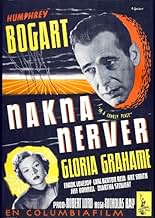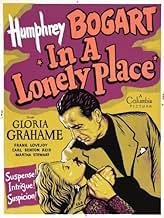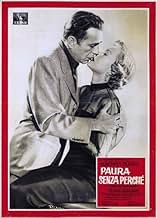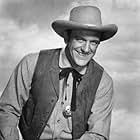A potentially violent screenwriter is a murder suspect until his lovely neighbor clears him. However, she soon starts to have her doubts.A potentially violent screenwriter is a murder suspect until his lovely neighbor clears him. However, she soon starts to have her doubts.A potentially violent screenwriter is a murder suspect until his lovely neighbor clears him. However, she soon starts to have her doubts.
- Awards
- 3 wins total
James Arness
- Young Detective
- (uncredited)
Pat Barton
- Second Hat Check Girl
- (uncredited)
David Bond
- Dr. Richards
- (uncredited)
Hazel Boyne
- Person
- (uncredited)
Laura K. Brooks
- Lady Wanting Matches
- (uncredited)
Storyline
Did you know
- TriviaIn her essay "Humphrey and Bogey", Louise Brooks wrote that more than any other role that Humphrey Bogart played, it was the role of Dixon Steele in this movie that came closest to the real Bogart she knew.
- GoofsAfter leaving the beach driving in his convertible, although Dix is going 70 MPH, neither his nor Laurel's hair is disturbed by the wind.
- Quotes
Dixon Steele: I was born when she kissed me. I died when she left me. I lived a few weeks while she loved me.
- ConnectionsEdited into Dead Men Don't Wear Plaid (1982)
Featured review
In 1950, Billy Wilder released his latest masterpiece, 'Sunset Blvd.,' a scathing satire on the pitfalls of Hollywood celebrity, delicately drawing a contrast between the deluded and volatile has-been Norma Desmond (Gloria Swanson) and the scheming wanna-be screenwriter Joe Gillis (William Holden). While Wilder's film deservedly received an overwhelming critical response, and its share of controversy, another impressive, similarly-themed film slipped beneath the radar that same year. For decades, director Nicholas Ray was overlooked and neglected by most film critics, before developing something of a cult following in the 1970s, and films such as 'Rebel Without a Cause (1955)' which I first watched just a week ago are now recognised as masterpieces. 'In a Lonely Place (1950)' has only now been lauded as one of the finest entries into the film-noir movement, and Humphrey Bogart's performance has emerged as among the most intense and profound in his distinguished repertoire. A brooding study of aggression, trust and success, Ray's film meticulously deconstructs the Hollywood myth, revealing a frightening world where the man you love could very well be a murderer.
Dixon Steele (Humphrey Bogart) is a down-on-his-luck screenwriter, an unsuccessful artist who resents being pressured into writing hackneyed, unoriginal scripts, which are guaranteed money-makers for the studios but possess zero artistic integrity. The morning after he brings home a bar hat-check girl (Martha Stewart) to recite the plot of the novel he is to adapt, Steele is hauled into the police department to explain why the girl was found murdered, her strangled body dumped from a moving vehicle. Appearing almost indifferent to the crime, Steele declines all knowledge of the homicide, and his story is shakily corroborated by a neighbour, Laurel Gray (Gloria Grahame), with whom he forms an intimate relationship. As Steele begins to pen his latest screenplay, he uncovers an outlet for his pent-up aggression, however, when Laurel betrays a lingering suspicion that her love might possibly have perpetrated the horrific murder, he threatens to lash out in a fit of violence, only further cementing her misgivings. By the film's end, the tragedy of the couple's relationship is revealed: whether or not Steele actually did commit the murder is almost irrelevant; what ultimately dooms their romance is that he conceivably could have.
In an obvious critique of the Hollywood studio system, Steele bitterly condemns the career of a successful producer, accusing him of remaking the same movie twenty times and of being a "popcorn salesman." The producer, apparently comfortable with his prosperous but creatively-deficient profession, snidely reminds Steele that everyone in Hollywood is inherently a "popcorn salesman," so why fight it? It's this notion of creativity or, rather, the lack of creativity in film-making that forms the heart of 'In a Lonely Place.' There's no doubt that Dixon Steele is a talented screenwriter, but his reluctance to allow his work to be influenced by popular opinion makes him feel trapped and alone, as though Hollywood is attempting to stamp out his genius. His frustration with the film-making business is allowed to accumulate steadily within, before being unleashed in adrenaline-charged explosions of aggression and violence. From here is born the dilemma of Laurel's relationship with him: it is Steele's creativity with which she most assuredly fell in love, but this gift is intrinsically linked with the hostility of which she is so frightened.
Dixon Steele (Humphrey Bogart) is a down-on-his-luck screenwriter, an unsuccessful artist who resents being pressured into writing hackneyed, unoriginal scripts, which are guaranteed money-makers for the studios but possess zero artistic integrity. The morning after he brings home a bar hat-check girl (Martha Stewart) to recite the plot of the novel he is to adapt, Steele is hauled into the police department to explain why the girl was found murdered, her strangled body dumped from a moving vehicle. Appearing almost indifferent to the crime, Steele declines all knowledge of the homicide, and his story is shakily corroborated by a neighbour, Laurel Gray (Gloria Grahame), with whom he forms an intimate relationship. As Steele begins to pen his latest screenplay, he uncovers an outlet for his pent-up aggression, however, when Laurel betrays a lingering suspicion that her love might possibly have perpetrated the horrific murder, he threatens to lash out in a fit of violence, only further cementing her misgivings. By the film's end, the tragedy of the couple's relationship is revealed: whether or not Steele actually did commit the murder is almost irrelevant; what ultimately dooms their romance is that he conceivably could have.
In an obvious critique of the Hollywood studio system, Steele bitterly condemns the career of a successful producer, accusing him of remaking the same movie twenty times and of being a "popcorn salesman." The producer, apparently comfortable with his prosperous but creatively-deficient profession, snidely reminds Steele that everyone in Hollywood is inherently a "popcorn salesman," so why fight it? It's this notion of creativity or, rather, the lack of creativity in film-making that forms the heart of 'In a Lonely Place.' There's no doubt that Dixon Steele is a talented screenwriter, but his reluctance to allow his work to be influenced by popular opinion makes him feel trapped and alone, as though Hollywood is attempting to stamp out his genius. His frustration with the film-making business is allowed to accumulate steadily within, before being unleashed in adrenaline-charged explosions of aggression and violence. From here is born the dilemma of Laurel's relationship with him: it is Steele's creativity with which she most assuredly fell in love, but this gift is intrinsically linked with the hostility of which she is so frightened.
- How long is In a Lonely Place?Powered by Alexa
Details
- Release date
- Country of origin
- Language
- Also known as
- La muerte en un beso
- Filming locations
- City Hall - 455 N. Rexford Drive, Beverly Hills, California, USA(exteriors: Dixon leaves police headquarters after first questioning; seen later from post office across street)
- Production company
- See more company credits at IMDbPro
Box office
- Gross worldwide
- $22,276
- Runtime1 hour 34 minutes
- Color
- Aspect ratio
- 1.33 : 1
Contribute to this page
Suggest an edit or add missing content
























